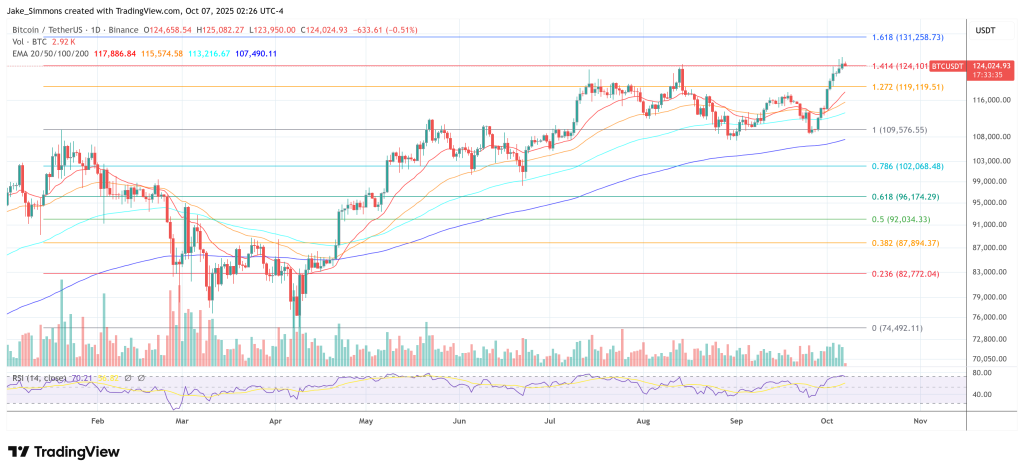Jeff Park, the chief investment officer at ProCap BTC and an advisor to Bitwise, refuted Paul Tudor Jones’ recent caution that markets “feel exactly like 1999.” He asserted that the macroeconomic landscape of 2025 is fundamentally distinct from the dot-com period and, crucially, more favorable for Bitcoin. Park’s remarks came after Jones’ interview on CNBC, during which the billionaire trader claimed the market setup mirrors the late-cycle surge before the tech crash, while still praising Bitcoin as a highly attractive asset.
Bitcoin Will Prosper, Not Plummet
In a X post, Park dismissed the parallels to 1999 as “lazy,” arguing that today’s asset price drivers are primarily influenced by fiscal and monetary factors that starkly contrast with the surplus-era, pre-QE environment of the late 1990s. “In 1999, markets were fueled by private sector enthusiasm during a time of minimal fiscal drag—the US government was actually in a budget surplus,” he noted. “Today, markets are significantly affected by substantial fiscal expenditure and debt monetization, with the US clearly burdened by debt.” Park summed up his stance: “So no. To me it doesn’t ‘feel exactly like 1999’ at all. It feels like an unmatched opportunity for those who are ready.”
Park highlighted the current Federal Reserve’s stance versus that of the Greenspan Fed during the peak of the dot-com bubble. “In 1999, the Fed was increasing rates, had a small balance sheet, and no QE. Conversely, in 2025, rates are falling, the balance sheet is large, and the acronyms are overwhelming,” he explained, asserting that abundant liquidity—now more uniformly spread globally—has become the hallmark of this cycle. He remarked that with the US Treasury General Account refilled, the world is “on the brink of a global liquidity spree.”
Related Reading
He also stressed the existence of significant cross-border feedback mechanisms absent 25 years ago, pointing to policy transfers and supply chain adjustments that link US risk assets to the global economy. Park pointed to Japan as a case in point on how foreign policy can enhance liquidity levels, citing pro-stimulus indications from new leadership. On Monday, Japanese stocks surged after Sanae Takaichi won the leadership of the ruling LDP amid expectations of ongoing fiscal support—an occurrence that markets interpreted as further encouragement for accommodation.
Park made a clear distinction between the dollar cycle of the late-1990s and the current macro hedging strategies, contending that, unlike the period from 2000 to 2002, gold is now “literally on a tear with every sovereign player involved.” On the day he made his comments, spot gold reached new all-time highs above $3,900 per ounce, a shift largely attributed to demand for safe havens and the anticipation of additional US rate cuts—context that reinforces Park’s argument regarding the current inclination toward hard assets.
Related Reading
While Jones perceives echoes of enthusiasm that might lead to negative outcomes, Park believes in a regime that directs liquidity toward scarce, non-sovereign assets—foremost among which is Bitcoin. He argued that “in 1999, there was no bitcoin, social media, or smartphones. By 2025, everyone globally has an escape valve in their pocket,” emphasizing Bitcoin’s structural differences from dot-com stocks: bearer settlement, programmatic issuance, and an expanding base of global distribution that can activate in real-time.
Paul Tudor Jones On Bitcoin
Jones maintains a positive outlook on Bitcoin, even as he cautions about an overheated market. During his CNBC appearance, he reiterated that the atmosphere “feels exactly like 1999,” echoing the Nasdaq’s rapid ascent into March 2000. Yet, he also reaffirmed Bitcoin’s allure—continuing a longstanding narrative in which he describes Bitcoin as a potent hedge against inflation and “one of the fastest horses.” This dual perspective—macro skepticism about equities and optimism for Bitcoin—prompted Park’s response that this cycle is “tailored for Bitcoin, not bubbles.”
Importantly, Park’s argument doesn’t deny the potential for sharp declines nor assures a one-way trajectory. Rather, it is predicated on the quality of liquidity, the nature of fiscal dominance, and the behavior of hard-asset hedges amid significant sovereign balance sheets. Gold’s concurrent breakout, Japan’s stimulus-oriented policy, and investors’ search for non-dilutive stores of value all support his core assertion that the 2025 landscape “is nothing like 1999”—and that Bitcoin, more so than the dot-com stars of the past, is set to be the primary beneficiary.
As of press time, Bitcoin was valued at $124,024.

Featured image created with DALL.E, chart from TradingView.com

